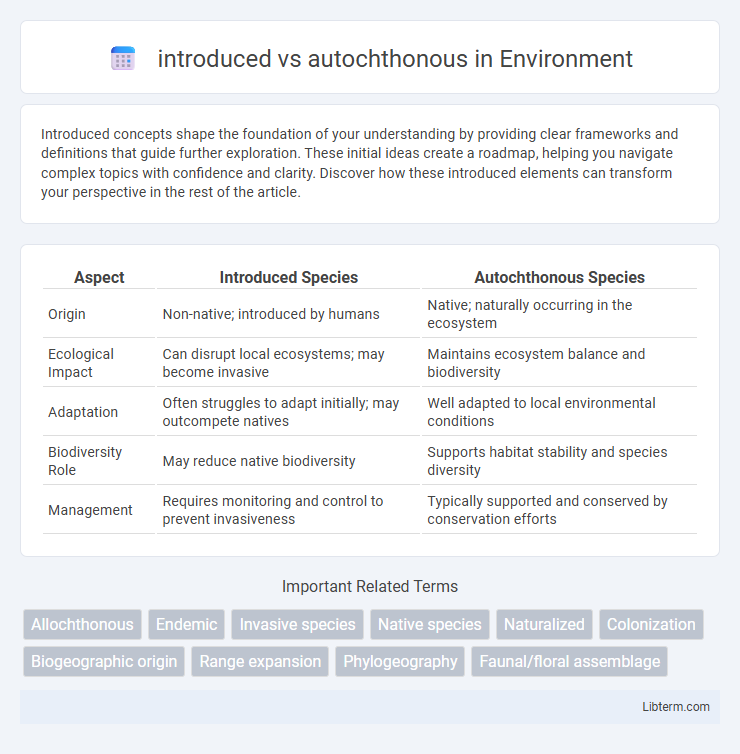Introduced concepts shape the foundation of your understanding by providing clear frameworks and definitions that guide further exploration. These initial ideas create a roadmap, helping you navigate complex topics with confidence and clarity. Discover how these introduced elements can transform your perspective in the rest of the article.
Table of Comparison
| Aspect | Introduced Species | Autochthonous Species |
|---|---|---|
| Origin | Non-native; introduced by humans | Native; naturally occurring in the ecosystem |
| Ecological Impact | Can disrupt local ecosystems; may become invasive | Maintains ecosystem balance and biodiversity |
| Adaptation | Often struggles to adapt initially; may outcompete natives | Well adapted to local environmental conditions |
| Biodiversity Role | May reduce native biodiversity | Supports habitat stability and species diversity |
| Management | Requires monitoring and control to prevent invasiveness | Typically supported and conserved by conservation efforts |
Definition of Introduced and Autochthonous Species
Introduced species are organisms brought by humans to new environments outside their native range, often through intentional or accidental means, which may become invasive and disrupt local ecosystems. Autochthonous species are native organisms that have naturally evolved and exist in a particular region without human intervention, maintaining ecological balance within their habitat. Understanding the distinction highlights the impact of human activities on biodiversity and ecosystem stability.
Origins and Historical Context
Introduced species originate from outside a given region, historically transported through human activities such as trade, colonization, or agriculture. Autochthonous species are native, evolving naturally within a specific ecosystem over geological timescales without human intervention. Understanding these origins helps clarify ecological dynamics and the impact of species on biodiversity and habitat stability.
Key Differences Between Introduced and Autochthonous Species
Introduced species, also known as non-native or exotic species, are organisms transported by human activity beyond their natural range, often disrupting local ecosystems. Autochthonous species originate and evolve within a specific region, maintaining ecological balance and supporting native biodiversity. The key differences lie in their origin, ecological impact, and adaptation, with introduced species frequently leading to invasive behavior, while autochthonous species contribute to ecosystem stability.
Ecological Impacts of Introduced Species
Introduced species often disrupt native ecosystems by outcompeting autochthonous species for resources, leading to reduced biodiversity and altered habitat structures. These non-native species can introduce new diseases, modify nutrient cycles, and trigger trophic cascades that destabilize ecological balances. Long-term ecological impacts include the decline of endemic populations and the homogenization of distinct biotic communities.
Importance of Autochthonous Species in Ecosystems
Autochthonous species, native to their natural habitats, play a crucial role in maintaining ecosystem stability by supporting biodiversity and facilitating nutrient cycling. Their long-term evolutionary adaptations enhance resilience against environmental changes and invasive species. Protecting autochthonous species ensures the preservation of ecological balance and ecosystem services essential for human well-being.
Human Influence on Species Distribution
Human influence on species distribution has led to the introduction of non-native species into new environments, often resulting in introduced species competing with or displacing autochthonous, or native, species. These introduced organisms can alter local ecosystems by disrupting established food webs, nutrient cycles, and habitat structures, potentially causing declines in native biodiversity. Understanding the dynamics between introduced and autochthonous species is critical for managing invasive populations and preserving indigenous ecosystems.
Case Studies: Introduced Species Around the World
Introduced species, often transported by human activity, have established populations in ecosystems worldwide, frequently disrupting native biodiversity and ecosystem functions. Case studies such as the introduction of the brown tree snake in Guam demonstrate severe impacts on native bird populations, while the Nile perch in Lake Victoria has led to significant declines in indigenous fish species. Understanding these examples highlights the ecological consequences of introducing non-native species compared to autochthonous species that naturally evolved within their environments.
Autochthony and Biodiversity Preservation
Autochthony plays a crucial role in biodiversity preservation by maintaining native species adapted to local ecosystems, which enhances ecological stability and resilience. Autochthonous species contribute to genetic diversity, support unique habitats, and prevent the dominance of invasive introduced species that can disrupt native food webs. Conservation strategies prioritize protecting autochthonous populations to sustain ecosystem services and preserve evolutionary heritage.
Management Strategies for Introduced Species
Management strategies for introduced species emphasize early detection, rapid response, and long-term monitoring to prevent establishment and spread. Techniques include mechanical removal, chemical treatments, and biological control agents tailored to specific invasive organisms. Effective management integrates habitat restoration and public awareness campaigns to reduce ecological impact and support native biodiversity conservation.
Future Perspectives and Conservation Challenges
Future perspectives in managing introduced versus autochthonous species emphasize enhancing genetic monitoring technologies and habitat restoration strategies to maintain ecosystem resilience. Conservation challenges include mitigating invasive species' impacts on native biodiversity and balancing human development with protecting endemic populations. Integrating advanced ecological modeling with community-based conservation efforts offers promising pathways for sustainable preservation of autochthonous species.
introduced Infographic

 libterm.com
libterm.com